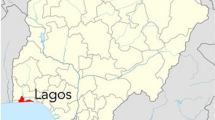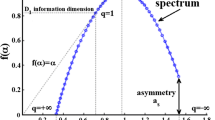Abstract
Weather represents the daily state of the atmosphere. It is usually considered as a chaotic nonlinear dynamical system. The objectives of the present study were (1) to investigate multifractal meteorological trends and rhythms at the Amazonian area of Ecuador and (2) to estimate some nonlinear invariants for describing the meteorological dynamics. Six meteorological variables were considered in the study. Datasets were collected on a daily basis from January 1st 2001 to January 1st 2005 (1,460 observations). Based on a new multifractal method, we found interesting fractal rhythms and trends of antipersistence patterns (Fractal Dimension >1.5). Nonlinear time series analyses rendered Lyapunov exponent spectra containing more than one positive Lyapunov exponent in some cases. This sort of hyperchaotic structures could explain, to some extent, larger fractal dimension values as the Kaplan–Yorke dimension was also in most cases larger than two. The maximum prediction time ranged from ξ = 1.69 days (approximately 41 h) for E/P ratio to ξ = 14.71 days for evaporation. Nonlinear dynamics analyses could be combined with multifractal studies for describing the time evolution of meteorological variables.





Similar content being viewed by others
References
Bak P, Tang C, Wiesenfeld K (1987) Self-organized criticality: an explanation of 1/f noise. Phys Rev Lett 59:381–385
Balling RC, Vose RS, Weber GR (1998) Analysis of long-term European temperature records: 1751–1995. Clim Res 10:193–200
Barry RG, Chorley RG (1985) Atmosphere, time and climate (in Spanish). Omega Editions S.A, 4th edn. Barcelona, Spain
Baveye P, Boast Ch, Gaspar S, Tarquis A, Millán H (2008) Introduction to fractal geometry, fragmentation processes and multifractal measures: theory and operational aspects of their application to natural systems. In: Senesi N, Wilkinson K (eds) Biophysical chemistry of fractal structures and processes in environmental systems, Chapter 2. Wiley, Chichester, pp 11–69
Chaudhuri S (2006) Predictability of chaos inherent in the occurrence of severe thunderstorms. Adv Complex Sys 9:77–85
Deidda R (2000) Rainfall downscaling in a space-time multifractal framework. Water Resour Res 36:1779–1794
Evertsz CJG, Mandelbrot BB (1992) Multifractal measures. In: Peitgen HO, Jürgens H, Saupe D (eds) Chaos and fractals, new frontiers of science. Springer, New York, pp 921–953
Ferguson SH, Messier F (1996) Ecological implications of a latitudinal gradient in inter-annual climatic variability: a test using fractal and chaos theories. Ecography 19:382–392
Frederickson P, Kaplan JL, Yorke ED, Yorke JA (1983) The Lyapunov dimension of strange attractors. J Diff Eq 49:185–207
Frisch U, Parisi G (1985) Fully developed turbulence and intermittency. In: Ghil M, Benzi R, Parisi G (eds) Turbulence and predictability of Geophysical Flows and Climate dynamics. North Holland, New York, p 84
Gutiérrez RM (2004) Optimal nonlinear models from empirical time series: an application to climate. Int J Bifur Chaos 14:2041–2052
Gutiérrez JM, Galván A, Cofiño AS (2006) Chaos game characterization of temporal precipitation variability: application to regionalization. Fractals 14:87–99
Hegger R, Kantz H, Schreiber T (1999) Practical implementation of nonlinear time series methods: The TISEAN package. Chaos 9:413–440
Hense A (1987) On the possible existence of a strange attractor for the Southern Oscillation. Beitr Phys Atmos 60:34–47
Higuchi T (1988) Approach to an irregular time series on the basis of the Fractal Theory. Physica D 31:277–283
Kalauzi A, Spasić S, Ćulić M, Grbić G, Lj M (2005) Consecutive differences as a method of signal fractal analysis. Fractals 13:283–292
Kalauzi A, Cukic M, Millán H, Bonafoni S, Biondi R (2006) Fractal rhythms and trends of rainfall data from Pastaza province, Ecuador and Veneto, Italy. In: Simos T, Maroulis G (eds) Lecture series on computer and computational sciences. Recent progress in computational sciences and engineering. Selected papers from the International Conference on Computational Methods in Sciences and Engineering, Crete, Greece, vol 7A, pp 241-244
Kalauzi A, Cukic M, Millán H, Bonafoni S, Biondi R (2009) Comparison of fractal dimension oscillations and trends of rainfall data from Pastaza Province, Ecuador and Veneto, Italy. Atmos Res 93:673–679
Kantz H (2004) A robust method to estimate the maximal Lyapunov exponent of a time series. Phys Lett A 185:77–87
Kantz H, Schreiber T (2003) Nonlinear time series analysis. Cambridge University Press, Cambridge
Kaplan DT, Glass L (1992) Direct test for determinism in a time series. Phys Rev Lett 68:427–430
Kaplan J, Yorke J (1987) Chaotic behavior of multidimensional difference equations. In: Peitgen HO, Walther HO (eds) Functional differential equations and approximation of fixed points. Springer, New York
Katz M (1988) Fractals and the analysis of waveforms. Comput Biol Med 18:145–156
Kodba S, Perc M, Marhl M (2005) Detecting chaos from a time series. Eur J Phys 26:205–215
Kurnaz ML (2004) Application of detrended fluctuation analysis to monthly average of the maximum daily temperatures to resolve different climates. Fractals 12:365–373
Lorenz E (1993) The essence of chaos. UCL, London
Mandelbrot BB (1989) Multifractal measures, especially for the geophysicist. Pure Appl Geophys 131:5–42
Mandelbrot BB (2003) Multifractal power law distributions: negative and critical dimensions and other “anomalies”, explained by a simple example. J Stat Phys 110:739–774
Millán H, Kalauzi A, Llerena G, Sucoshañay J, Piedra D (2008) Climatic trends in the amazonian area of Ecuador: classical and multifractal analyses. Atmos Res 88:355–366
Millán H, Kalauzi A, Llerena G, Sucoshañay J, Piedra D (2009) Meteorological complexity in the Amazonian area of Ecuador: an approach based on Dynamical System Theory. Ecol Complex 6:278–285
Primo C, Galván A, Sordo C, Gutiérrez JM (2007) Statistical linguistic characterization of variability in observed and synthetic daily precipitation series. Physica A 374:389–402
Rangarajan G, Sant DA (2004) Fractal dimensional analysis of Indian climatic dynamics. Chaos, Solitons Fractals 19:285–291
Sano M, Sawada Y (1985) Measurement of the Lyapunov spectrum from a chaotic time series. Phys Rev Lett 55:1082–1085
Sivakumar B (2004) Chaos theory in geophysics: past, present and future. Chaos, Solitons Fractals 19:441–462
Sprott JC (2007) Maximally complex simple attractors. Chaos 17:033124–6
Theiler J, Eubank S (1993) Don´t bleach chaotic data. Chaos 3:771–782
The MathWorks Inc (1999) MATLAB: the language of technical computing, version 5.3.1.29215a. MathWorks, Natick
Tsonis AA (2001) The impact of nonlinear dynamics in the atmospheric sciences. Int J Bifurc Chaos 11:881–902
Valdez-Cepeda RD, Hernández-Ramírez D, Mendoza B, Valdés-Galicia J, Maravilla D (2003) Fractality of monthly extreme minimum temperature. Fractals 11:137–144
Washington R (2000) Quantifying chaos in the atmosphere. Prog Phys Geog 24:499–514
Zhou X, Persaud N, Wang H (2005) Periodicities and scaling parameters of daily rainfall over semi-arid Botswana. Ecol Model 182:371–378
Acknowledgments
This work was supported by the Ministry of Science and Environmental Protection of the Republic of Serbia (projects 143045 and 143027). We thank National Institute of Meteorology and Hydraulic Resources (I.N.A.M.H.I, Ecuador) for access to the climatic database. The present investigation was conducted while the first author served as an invited professor of Environmental Physics at Amazonian State University (Ecuador).
Author information
Authors and Affiliations
Corresponding author
Rights and permissions
About this article
Cite this article
Millán, H., Kalauzi, A., Cukic, M. et al. Nonlinear dynamics of meteorological variables: multifractality and chaotic invariants in daily records from Pastaza, Ecuador. Theor Appl Climatol 102, 75–85 (2010). https://doi.org/10.1007/s00704-009-0242-6
Received:
Accepted:
Published:
Issue Date:
DOI: https://doi.org/10.1007/s00704-009-0242-6




